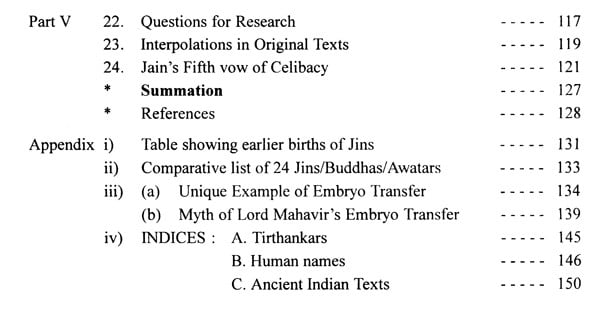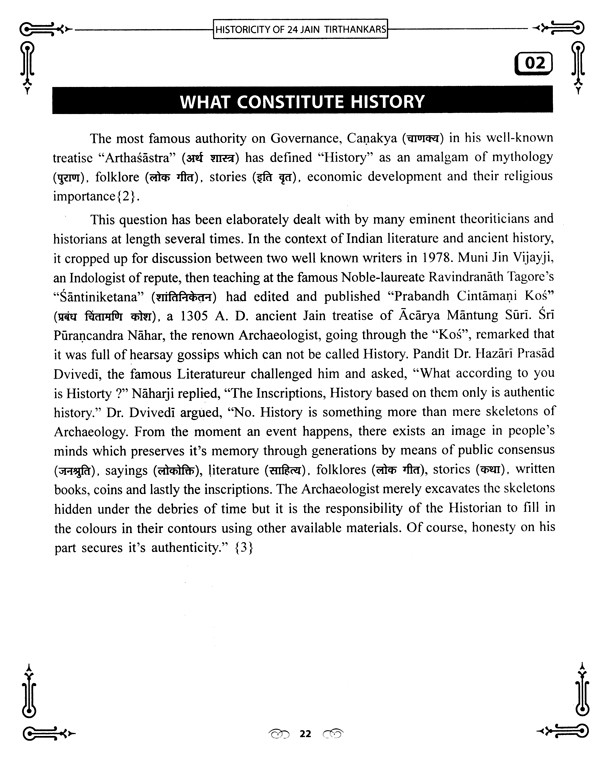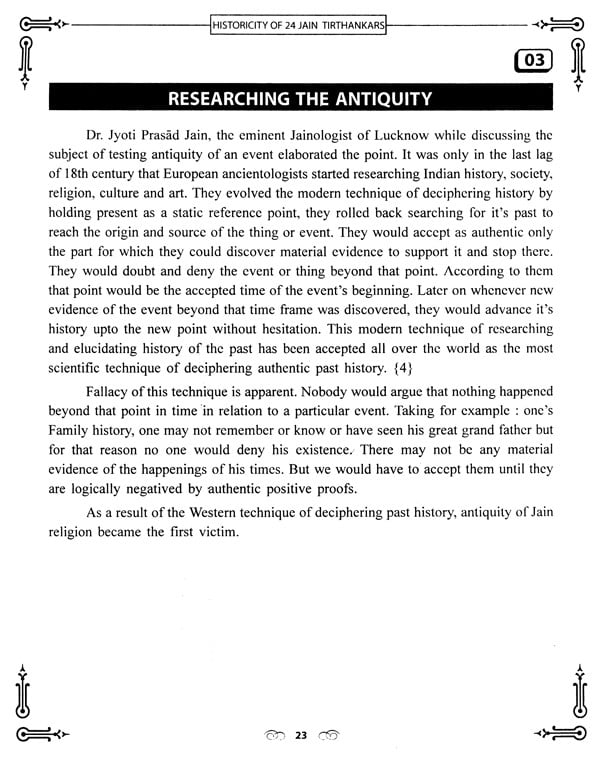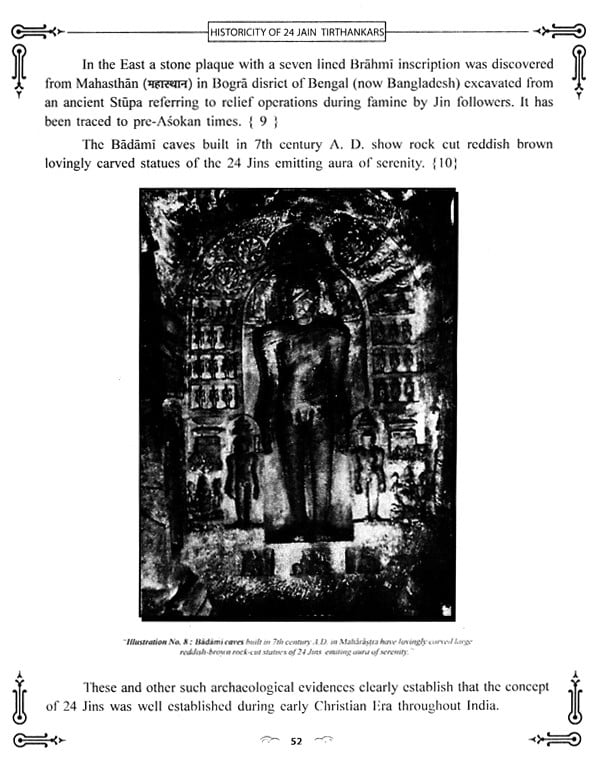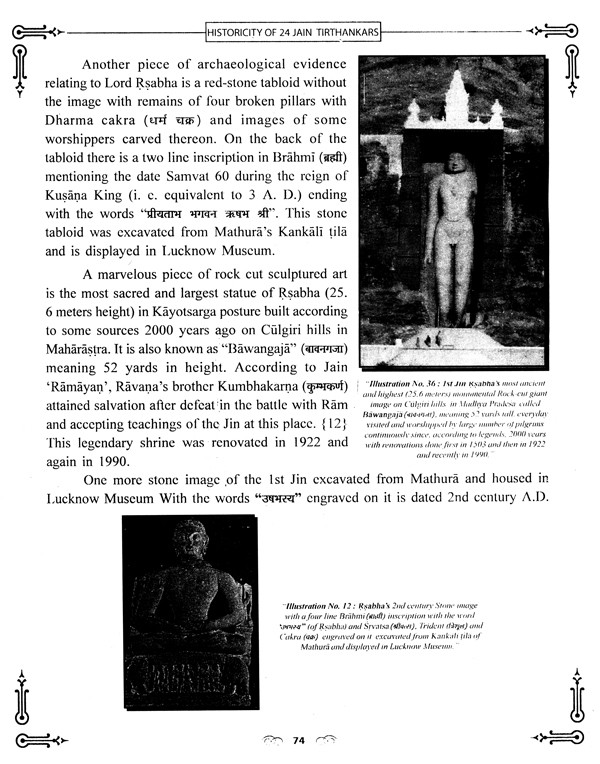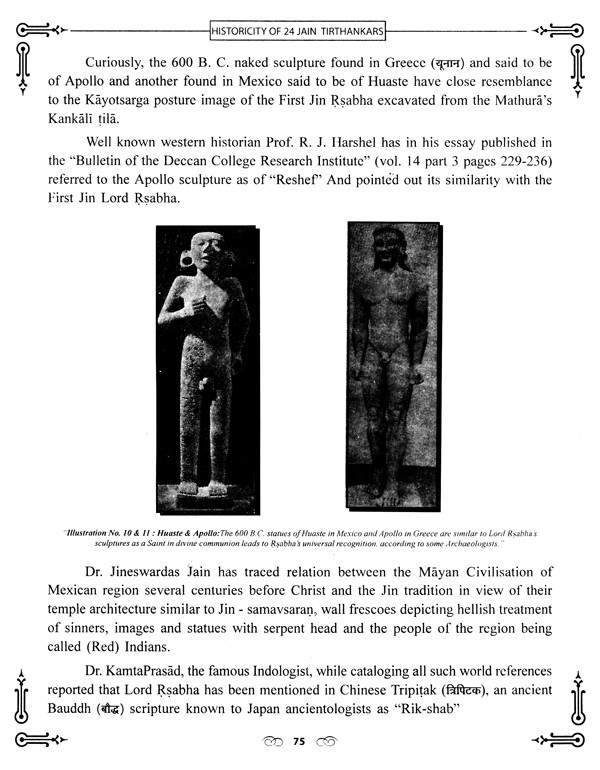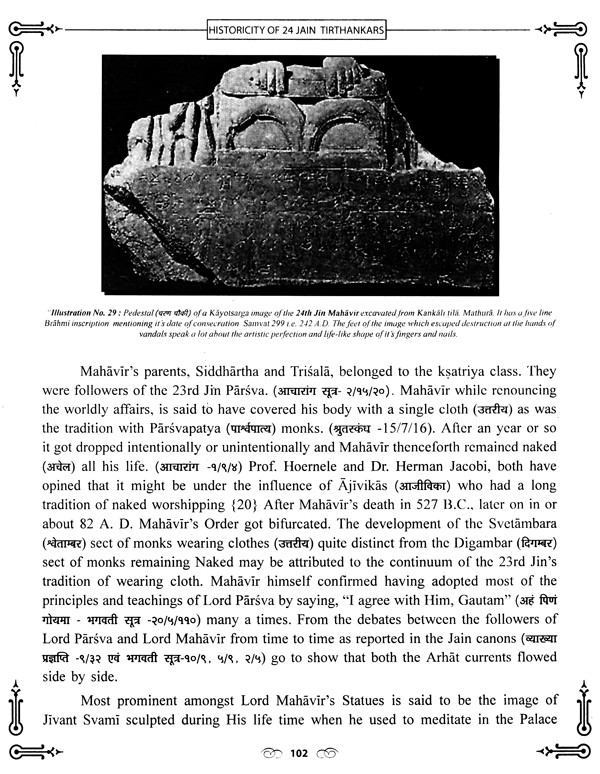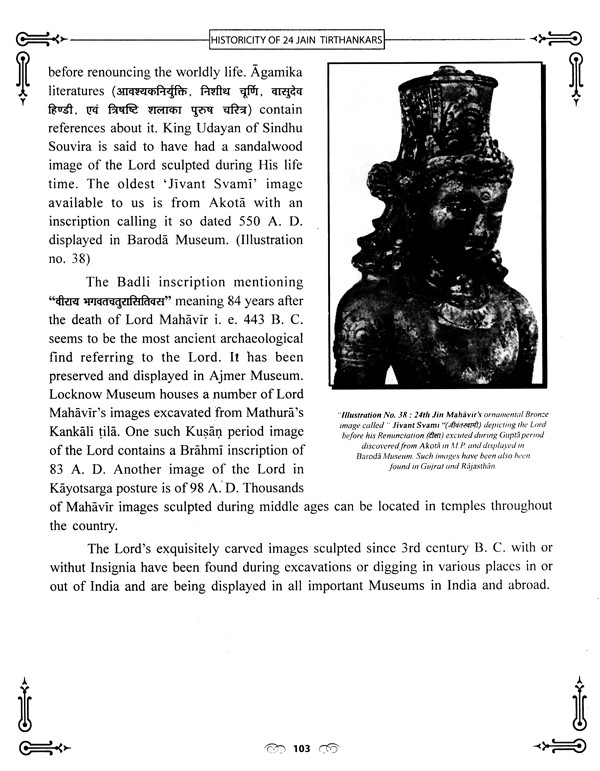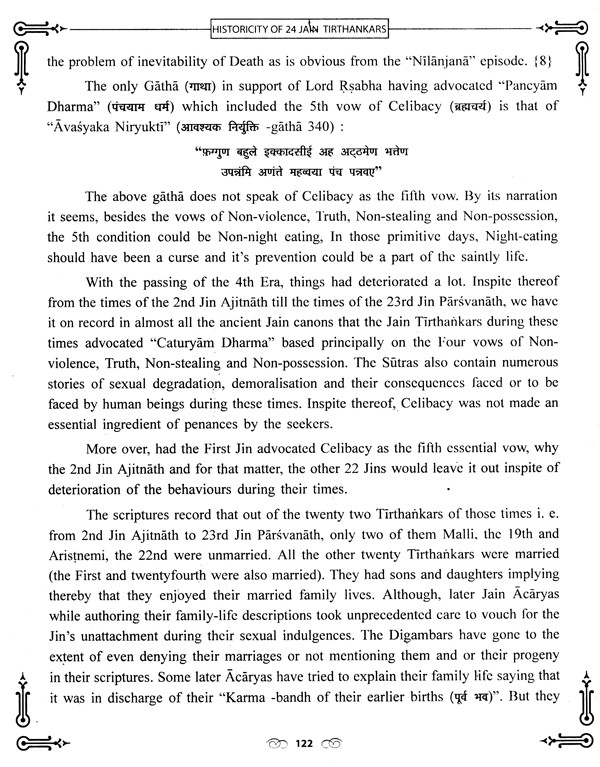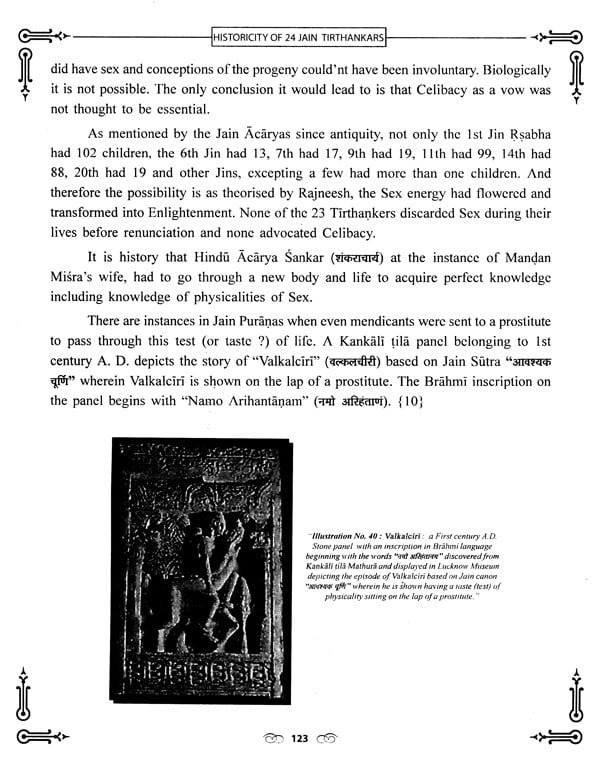
Historicity of 24 Jain Tirthankars
Book Specification
| Item Code: | UAB335 |
| Author: | Mangilal Bhutoria |
| Publisher: | Priyadarshani Prakashan, Jaipur |
| Language: | English |
| Edition: | 2006 |
| ISBN: | 8190094017 |
| Pages: | 152 (Throughout B/w Illustrations) |
| Cover: | HARDCOVER |
| Other Details | 11.00 X 9.00 inches |
| Weight | 690 gm |
Book Description
Bhutoria's scholarly velour is heroic as he works his way through the unexplored plateaus of demeaning dereliction exemplified by consistent and culpable rejection of the Jain tradition of twenty four Tirthankaras by scholars who found themselves in a black hole quandary. European scholars were so baffled by the incomprehensible Jain calculations of time which led them to a rationalized and escapist preference for adopting an indifferent and negative approach, The Indian scholars too found it convenient to follow in European footsteps. Not even the effulgent appearance of the classic poetic work, "The Light of Asia" on the canvas of European mind led them to a quest of the older branch of Sramana antiquity and its history, sociology, philosophy, natural sciences, ethics, or the historicity of the 24th Jain Tirthankaras. For a while, the escapists found intellectual comfort in the error of assuming that Jainism was a branch of Buddhism. So huge and blunderbuss was that error that some scholars went to the extent of assuming that Lord Mahavira and Lord Buddha were the same person. Unmindful of the fact that Lord Mahavira and Lord Buddha were contemporaries and both represented the two sides of the same Sramana coin. Both of them appeared on the scene when the traditions and teachings of Lord Parsvanath held sacred and philosophical sway in India. It is my view that both Lord Mahavira and Lord Buddha were born in families and communities which followed the teachings of Lord Parsvanath, the twenty third Tirthankara of the Jain tradition. All , three represented, sociologically speaking, the Kshatriya upsurge and the wider social protest against the excesses of Brahamanial aristocracy and its ritual obsessions, the rituals of animal sacrifice. The period of time between the twenty second to the twenty fourth Jain Trirthankara and Lord Buddha was in my opinion, a period of time when the strong revival of Sramana tradition played a catalytic role in the churning process of Vedanta and the embryonic rise of gentler Saiva and Vaishnava traditions. That was a period marked by Advaita Vedanta and Sramana Vedanta.
The British, European and Indian Ideologists abandoned the issue of the historicity of the 24 Tirthankaras mainly because they were unable to establish the precise chronology of the Tirthankaras.
It was obviously the easy way out for them to treat the tradition with disparaging doubt, derision and disbelief. The approach of ready and easy rationalization adopted by them was to hold in effect that what was incomprehensible and unintelligible to them simply did not exist. The easy-going logic of the scholars and escapists following each other is obviously flawed. That attitude of mind is like saying that if one does not have proof or birth certificates of one's own or those of one's ancestors how can it is claimed that such a person or his ancestors ever existed!
Bhutoria is not able to offer a solution to the jigsaw puzzle of precise century-wise chronology of the 24 Tirthankaras, their authenticated dates of birth and nirvana, except those of the last two Tirthankaras but that would be a poor reason for any historian to deny the existential historicity of the 24 Tirthankaras. For many millennia the tradition of the 24 Tirthankaras has been handed down from generation to generation in different parts of the country. Their chronological sequence is equally a part of long and established tradition. For thousands of years that sacred sequence has been committed to memory and repeated by rote as a ritual of daily worship. Everyone is aware of the custom of paying homage to each Tirthankara in an individually earmarked sanctum or niche birth anniversaries and nirvana each Tirthankara attained. To dismiss it all as a mere make believe is the consequence of attitudes actuated by ill will and prejudice and steeped in ignorance and ill-humor.
All that the British Ideologists were able to do was to establish the dates and the historicity of Lord Mahavira and Lord Buddha. They found the Jain descriptions of eras and other units of time incomprehensibly baffling and entirely speculative and imaginary. The received and established legacy of the twenty four Tirthankaras in the Jain tradition was for them too much to cope with in terms of precise chronology. The easier option for western Ideology was to reject it all, lock, stock and barrel and to push the Sramana tradition to the margins. They found Buddhism a known quantity in terms of historicity and remained oblivious of the older tradition of Jains whose antiquity was erroneously ignored, obscured and obfuscated. For a long time, European did not; even Indeed Indologist did not accept the historicity of Lord Parsvanath, the Twenty third Tirthankara. It was the profound research and forceful logic of a great German scholar, Professor Herman Jacobi and his personal eminence and authority which established the historicity and roughly the period of time when the Twenty-third Tirthankara, Lord Parsvanath lived and taught. It was that European imprimatur provided by Professor Jacobi which established 9th century B. C. as the period of time in which Lord Parsvanath lived, travelled and taught. To him Jain Ideology owes an abiding debt of gratitude for being honest, just, reasonable, persuasive and authoritative.
What Mangilal Bhutoria does is to persist with humility and perseverance honestly and indefatigably following in the footprints of Professor Herman Jacobi, using the tools of indologicallogic and his own particular love, sympathy and dedication of an insider of the Jain tradition which is of notable value in this Himalayan expedition which I would call a Jain Indological pilgrimage in an unexplored, unmapped and undiscovered terrain. He challenges the conventional modes and moulds of limited approach of scholarship which placed exclusive reliance on inscriptions sculptures and objects of utility in stone or copper and other similar bits and pieces of evidence, and discarded the prevailing traditions and practices as also the hard evidence of stone, metal and inscription which indicated beyond an iota of doubt the existential and sequential historicity of the 24 Tirthankaras. Indeed the inherited tradition of collective convention, belief, practice, rituals, worship and the memory and the sequence of the 24th Tirthankaras as the part of daily ritual of worship from generation to generation is of no less importance than the evidence of copper, stone and inscription. Mangilal Bhutoria has blazed a trail and unfolds the panoramic vista of the existential and sequential historic- thirty of 24 Tirthankaras and the primeval antiquity of the Tirthankara tradition of yore.
I am grateful and indebted to the many reputed authors whose books, set out in the References, I went through. I express my deep gratitude to them for the quotes and reproductions I have used to emphasize a point especially to Dr. Calendar Restage, exdirector Lucknow Museum, Late Sri Ganesh Lalwani of Jain Bhavan, Kolkota and Sri Kurt Titze, a German Jain-lover. I am thankful to the Librarians of "Prakrit Bharati Granthagar", Jaipur, Asiatic Society, Kolkata, and "Jain Viswa Bharati Granthagar", Ladnun for allowing me access to their rich collection of rare books.
I express my deep gratitude to Dr. Nalini Joshi of the famous Bhandarkar Oriental Research Institute, Pune for kindly going through the manuscript and making valuable suggestions. Dr. Luxmi mull Singhvi, the famous Jurist, Ex-Indian High Commissioner in U.K. has always inspired me. His valued Foreword to my First books “History of Oswals " was a thesis in itself. It was independently published by magazines. I shall remain ever indebted to him for guiding and favoring me with his illuminating and inspiring 'Foreword' to my work.
My endeavors might not have been fruitful if Dr. Jag tram Bhattacharya, the Learned Registrar of Jain Viswa Bharati University, Ladnun had not appreciated it. He very kindly gave me an opportunity to present the outlines of the subject at a seminar held in the University auditorium followed by elaborated discussion by distinguished Jainologists. I am thankful to all of them. I ani grateful to Sri D.R. Mehta of Prakrit Bharati Academy, Sri K.L. Jain of Sri Sumermal Patawari Trust, Sri Ramesh Kundalia of Prajna Prakashan, Sri Bhanwarlalji Jain of lain Irrigation Systems Ltd.; Sri Nirmal Sethia of N. Sethia Foundation and Sri Abhay Firodia of Shri Firodia Trust for accepting my request for co-publishing the work, Sri Sardarmal Kankaria, Sri Milapchand Dugar and Sri Sardulsingh Bhutoria for patronizing the publication.
In my criticism of some scholars and their works, I might have been a bit harsh but that is how I felt. I am always conscious of my short comings and limitations. I most humbly apologise for the mistakes I might have made.
More important and worth discussions for ....them were the questions pertaining to Life and its goal, right perception of Nature and its relationship with Living-beings. History never bothered Indian mind. And that is why we do not have in our ancient scriptures chronologically serialized account of the events. Knowledge gained in the past led them to newer techniques for upliftment of the Soul. They used the past as examples to emphasize a point. Past was a stepping stone for the future. But factuality of the past- events was neither questioned nor was material. The happenings in the past were treated as an article of Faith which gave them strength to achieve the Ultimate.
Indian Rises used to mix up elements of religion, economics, sex and salvation in their tell-a-tale sermons for the seekers. "Ramayana" might have happened in or about 5000 years' B.C. {16}; It remained engrained in the mind of masses. Maharsi Valmiki well-versed the great Epic for the benefit of masses later on. "Mahabharata" took place in or about 3100 years B.C. and the sage Vedvyas entreated the tale from public memory in a kinescope form after a long time. Now both the tales form a part of Indian history.
During the last millennium there had been serious efforts by western historians to unearth events of the past and chronologically retrace happenings. Their emphasis has been on excavations. Archaeological evidence, no doubt, authenticates a fact. piece of evidence contemporary to the period of happening is far more important and should be given preedanee .and credence but its availability is not always possible. After a gap of millions of years since the birth of Civilization taking into account the upheavals on the Earth, it may be impossible to find concrete evidence of a particular event or happening which lies buried under the debris of time. The absence of such an evidence is also not enough to' negate the event. The maxim has to be always remembered that positive evidence to disprove an existing record is a MUST.
Dr. Vijnesha Mohan in his treatise "Philosophical Archaeology"(2DOO) has analyzed the situation thus: "Explanation of the past phenomenon only require logical cohesiveness instead of a preoccupation with hyper rationalism and pseudo scientific didacticism. Obsession with rigid or near-sighted empiricism is endlessly inconclusive. In History and Archaeology, there is hardly any scope for absolute certainty. Therefore Archaeology is increasingly empowered to imaginatively predict backwards and develop multi lineal culture."
Book's Contents and Sample Pages

